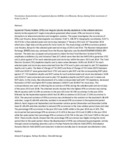| dc.contributor.author | Nyongesa, Edward | |
| dc.contributor.author | Ndinya, Boniface | |
| dc.contributor.author | Omondi, George | |
| dc.date.accessioned | 2021-12-31T08:40:54Z | |
| dc.date.available | 2021-12-31T08:40:54Z | |
| dc.date.issued | 2021-01 | |
| dc.identifier.uri | https://doi.org/10.14419/ijaa.v9i1.31262 | |
| dc.identifier.uri | https://www.sciencepubco.com/index.php/IJAA/article/view/31262 | |
| dc.identifier.uri | http://ir-library.mmust.ac.ke:8080/xmlui/handle/123456789/1954 | |
| dc.description.abstract | Equatorial Plasma Bubbles (EPBs) are irregular plasma density depletions in the ambient electron density in the equatorial F-region ionosphere generated after sunset. EPBs are known to bring disruptions to telecommunication and navigation systems. This paper investigates the occurrence of EPBs over Kisumu, Kenya (Geomagnetic coordinates: 9.64o S, 108.59o E; Geographic coordinates: 0.02o S, 34.6o E) for a few selected quiet and storm days between 1st January 2013 and 31st December 2014 which was a high Solar activity period for Solar Cycle 24. The study brings out EPB occurrence pattern over Kisumu, Kenya for the selected quiet and storm days of 2013 and 2014. The Receiver Independent Exchange (RINEX) data was retrieved from the Kisumu high data-rate NovAtel GSV4004B SCINDA-GPS receiver. The data was unzipped and processed to obtain Vertical Total Electron Content (VTEC), amplitude scintillation (S4) and Universal Time (UT) which were then fed into MATLAB to generate VTEC and S4 plots against UT for each selected quiet and storm day within the years 2013 and 2014. The Total Electron Content (TEC) depletion depths and S4 index values between 16:00 and 20:00 UT for each selected quiet and storm day were extracted from the VTEC and S4 plots and used to plot TEC depletion depths and S4 plots. The Rate of Change of TEC (ROT) and Rate of Change of TEC Index (ROTI) between 16:00 and 20:00 UT were generated from VTEC and used to plot ROT and the corresponding ROTI plots against UT. TEC depletion depths and ROTI values for each selected quiet and storm day between 16:00 and 20:00 UT were extracted and used to plot TEC depletion depths and ROTI plots and S4 index and ROTI plots. In this study, the enhancement of S4 index corresponded well with TEC depletions, increased fluctuation of ROT and higher ROTI values between 16:00UT and 20:00UT for most days. This correspondence was used in inferring the occurrence of EPBs during the selected quiet and storm days of the years 2013 and 2014. The obtained results showed that the highest EPB occurrence was during March equinox with 33.33% occurrence in the year 2013 and 30.76% occurrence in the year 2014, followed by the September equinox which had 20.38% occurrence in 2013 and 17.26% occurrence in 2014. The seasonal variation of EPB occurrence was attributed to the variation in the daytime E x B drift velocities. Larger E x B drift velocities resulted in increased EPB occurrence in the equinoctial period (March, April, August and September) and November solstice period (November and December) while lower E x B drift velocities resulted in reduced EPB occurrence in the June solstice period (June and July). The percentage EPB occurrence in the year 2013 was 6.49% while in the year 2014 was 4.32%. The storm period had percentage EPB occurrence of 21.42% in the year 2013 and 21.88% in the year 2014 while the quiet period had percentage EPB occurrence of 18.75% in the year 2013 and 7.89% in the year 2014. These results clearly showed that the percentage EPB occurrence was higher during the storm period than in the quiet period. Hence the development of EPBs was enhanced by geomagnetic activity through several competing dynamics such as Prompt Penetration Electric Field (PPEF), Disturbance Dynamo Electric Field (DDEF) and reduction in electron density due to increased recombination rates. | en_US |
| dc.language.iso | en | en_US |
| dc.publisher | International Journal of Advanced Astronomy Occurrence | en_US |
| dc.subject | Occurrence, characteristics, equatorial, plasma, bubbles , during, Solar, maximum ,Cycle 24 | en_US |
| dc.title | Occurrence characteristics of equatorial plasma bubbles over Kisumu, Kenya during Solar maximum of Solar Cycle 24 | en_US |
| dc.type | Article | en_US |

